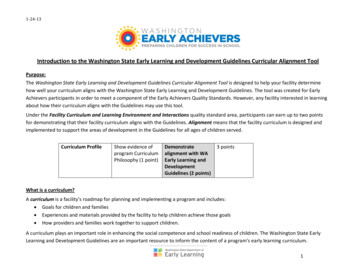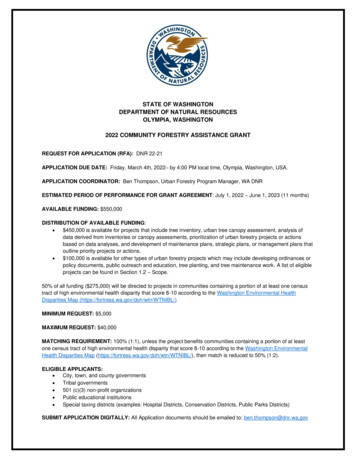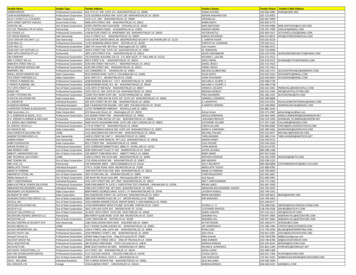
Transcription
1-24-13Introduction to the Washington State Early Learning and Development Guidelines Curricular Alignment ToolPurpose:The Washington State Early Learning and Development Guidelines Curricular Alignment Tool is designed to help your facility determinehow well your curriculum aligns with the Washington State Early Learning and Development Guidelines. The tool was created for EarlyAchievers participants in order to meet a component of the Early Achievers Quality Standards. However, any facility interested in learningabout how their curriculum aligns with the Guidelines may use this tool.Under the Facility Curriculum and Learning Environment and Interactions quality standard area, participants can earn up to two pointsfor demonstrating that their facility curriculum aligns with the Guidelines. Alignment means that the facility curriculum is designed andimplemented to support the areas of development in the Guidelines for all ages of children served.Curriculum ProfileShow evidence ofprogram CurriculumPhilosophy (1 point)Demonstratealignment with WAEarly Learning andDevelopmentGuidelines (2 points)3 pointsWhat is a curriculum?A curriculum is a facility’s roadmap for planning and implementing a program and includes: Goals for children and families Experiences and materials provided by the facility to help children achieve those goals How providers and families work together to support children.A curriculum plays an important role in enhancing the social competence and school readiness of children. The Washington State EarlyLearning and Development Guidelines are an important resource to inform the content of a program’s early learning curriculum.1
1-24-13Early Achievers does not require participants to use a specific curriculum. Rather, curricula should be aligned with the Guidelines andreflect the values and philosophy of the facility and the children and families served.What are the Washington State Early Learning and Development Guidelines?The Washington State Early Learning and Development Guidelines are a statewide resource for families, caregivers, child careprofessionals, teachers and others who care for or work with children. They are designed to provide essential information to support andenhance children’s learning and development. Several key resources were considered in creating the Guidelines, including Washington’s2005 Early Learning and Development Benchmarks, early learning standards from other states, Head Start and Early Childhood Educationand Assistance Program (ECEAP) standards, and our state’s academic learning standards. The Guidelines provide an update to the previousEarly Learning and Development Benchmarks including a focus on reflecting the rich cultural diversity of Washington State and expandingthe ages covered to include children up to 3rd grade.The Guidelines are organized by age of children and areas of development:Age: Young infants (birth to 11 months)Older infants (about 9 months to 18 months)Toddlers: (about 16 to 36 months)Ages 3 to 4 yearsAges 4 to 5 yearsAge 5 and Kindergarten1st grade (usually 6 years)2nd grade (usually 7 years)3rd grade (usually 8 years)Domains or Areas of Development: About me and my family and culture Building relationships Touching, seeing, hearing and moving around Growing up healthy Communicating Learning about my worldTo download the full publication, visit: lines.pdf2
1-24-13Why is it important that facility curriculum align to the Washington State Early Learning and Development Guidelines?Curriculum that is aligned with the Guidelines helps ensure that all children across age groups and settings receive developmentallyappropriate instruction and learning experiences. It is important to remember that the Guidelines alone are not the curriculum, butare the foundation for building a curriculum that includes families and supports the social competence and school readiness ofchildren.What does the Washington State Early Learning and Development Guidelines Curricular Alignment Tool help me do?Providers complete the Washington State Early Learning and Development Guidelines Curricular Alignment Tool worksheets(available as a separate document) to demonstrate how their facility’s curriculum is aligned with the Guidelines. Providers willcompare and match their facility’s curriculum goals, activities or objectives to the Guidelines framework. The tool is organized by:Guidelines areas of development; ages of children; and specific learning goals that align to the areas of development1. In addition,the tool includes the domains from the Head Start Child Development and Early Learning Framework (HSCDELF, 2010) soparticipants can see how Guidelines and their facility curriculum lines up with national standards.The tool helps providers look at how their curriculum aligns with the Guidelines in two different but equally important ways:1. Coverage & Balance: Providers can use the tool to review their curriculum to ask: Does my curriculum cover each domain, or area of child development? Is the coverage balanced within and across domains?Coverage how well the curriculum addresses all or mostchild development domains. For example, “Am I including activities that support thedevelopmental tasks in the area, Communication, as well asdevelopmental tasks in the area Building Relationships?”Balance how much each domain is represented within thecurriculum. Is each area covered and how thoroughly? Are thereareas that aren’t included? For example, “Am I adequately addressing the developmental tasksin the area Communication throughout my learning activities?”1 The 2012 Washington State Early Learningand Development Guidelines were created to be in harmony with the domains and learning goals from the 2005Washington State Early Learning and Development Benchmarks. The learning goals listed on the curricular alignment tool are adapted from the Benchmarksand the Head Start Child Development and Early Learning Framework. These learning goals are aligned to the Guidelines’ indicators and ideas to try withchildren, and highlight developmental tasks that span across the ages. For more information on the creation of the Guidelines, refer to The Washington StateEarly Learning and Development Guidelines.3
1-24-132. Depth & Difficulty: Providers can use the tool to take a deeper look at their curriculum to make sure it supports the range ofskills and developmental levels of the children served. The tool will help providers reflect on their curriculum to ask: Does the curriculum support children’s skills with enough depth and difficulty to support child development?Depth how well a curriculum provides a sequence ofactivities that match children’s developing and increasing skillsDifficulty whether the curriculum helps children to reachbeyond their exisiting skills by providing them withdevelopmentally appropriate challenges and supportsWho should complete the Washington State Early Learning and Development Guidelines Curricular Alignment Tool?The tool is best completed with teams of teachers as a professional development exercise. If providers work alone, as in the case ofsome family child care providers, it is recommended that they find a community of providers or parents to work with to help themreflect on their curriculum. If this is done, those community members can be listed as “teachers” on the front page of the CurricularAlignment Tool.Steps to complete the Washington State Early Learning and Development Guidelines Curricular Alignment Tool worksheets:1. Determine the best approach to review your curriculum:There are two different approaches that providers may use to complete the tool. Providers may choose to complete the tool inboth ways for the most rigorous examination of their curriculum, but only one approach is required. The approach you chooseshould be noted on the front page of the tool. Emergent approach: This approach works best for facilities that use emergent or project-based curricula, (e.g., ReggioEmilia), or that integrate different curricular philosophies to support an overarching theory of child development andlearning. In this approach, providers identify the learning goals for each of their learning activities, and then write theactivities in the space next to the learning goals. (See Example 1) Published approach: This approach works best for facilities that use established (e.g., Creative Curriculum) or researchbased (e.g., Tools of Mind) curriculum. In this approach, providers will write the goals from the curriculum in the spacenext to the learning goals. (See Example 2)4
1-24-132. Complete table and questions for each area of development:Providers will complete one table and a series of questions for each of the six areas of development. Providers should completethe tables first, and then use that information to answer the questions for each area. Each table will be filled out according theEmergent or Published approach identified by the provider. The “totals” columns can help you keep track of whether an area isrepresented and for which age groups as you go along—this can help you later when you are ready to complete the summaryreflection at the end of the tool.3. Complete Curricular Alignment Tool Summary:At the end of the document, you will have the opportunity to reflect on how well your curriculum addresses all the areas ofdevelopment of the Guidelines for all of the children in your program. Fill out the summary table by placing a check mark toindicate whether or not the each area is addressed by your curriculum. Then answer the provided questions to reflect on theextent of your program’s curriculum coverage, balance, depth and difficulty.5
1-24-13Example 1--Emergent review of curriculum.ELG Area of DevelopmentHS DomainTouching, seeing, hearing, moving aroundPhysical Development & Health, Creative Arts Expression, English Language DevelopmentObjectives/Goals/Activities from Curriculum that Address Goals for Age-groups ServedLearning Goals3 - 4 yearsDemonstrate strength/coordination oflarge motor muscles - the control of large Native American History Project: Scavenger Hunt/Nature walk to findmuscles for movement, navigation andmaterials for puppet making and try out different large motor skillsbalanceDemonstrate strength/coordination ofsmall motor muscles- the control of smallmuscles for movement, navigation andbalanceChildren use senses to guide motionsDemonstrate stamina and energy toparticipate in daily activitiesChildren engage in a variety of physicalactivitiesChildren use their bodies and movementsto express themselvesDual Language Learners: Adaptions havebeen made so that activities are accessibleto Dual Language LearnersNative American History Project: Necklace making activity with beadsequencing; storybook character drawing activity; Puppet making activitywith buttons made out of natural materialsNative American History Project: Scavenger Hunt/Nature walk to findmaterials for puppet making and try out different large motor skillsNative American History Project: Scavenger Hunt/Nature walk to findnatural materials for puppet making and try out different large motorskillsNative American History Project: Scavenger Hunt/Nature walk; NativeAmerican DancesNative American History Project: Native American DancesNative American History Project: Identified key terms and had themtranslated, developed a series of gestures to use in explaining steps inactivities, and paired Dual Language Learners with peers6
1-24-13Example 2--Published review of curriculumELG Area of DevelopmentTouching, seeing, hearing, moving aroundHS DomainPhysical Development & Health, Creative Arts Expression, English Language DevelopmentObjectives/Goals/Activities from Curriculum that Address Goals for Age-groups ServedLearning Goals3 - 4 yearsObj.4. Demonstrates traveling skills (a) walks; (b) runs; (c) gallops andskipsDemonstrate strength/coordination of largemotor muscles - the control of large muscles formovement, navigation and balanceObj. 5. Demonstrates balancing skills (a) Sits and stands; (b) Walks onbeam; (c) Jumps and hopsObj. 6. Demonstrates gross-motor manipulative skills (a) Throws; (b)Catches; (c ) KicksDemonstrate strength/coordination of small Obj.7. Demonstrates fine-motor strength and coordination (a) Uses fingersmotor muscles- the control of small muscles forand hands; (b) Uses writing and drawing toolsmovement, navigation and balanceChildren use senses to guide motionsDemonstrate stamina and energy to participatein daily activitiesObj. 5. Demonstrates balancing skills (a) Sits and stands; (b) Walks onbeam; (c) Jumps and hopsObj.4. Demonstrates traveling skills (a) walks; (b) runs; (c) gallops andskipsObj.4. Demonstrates traveling skills (a) walks; (b) runs; (c) gallops andskipsChildren engage in a variety of physical activitiesObj. 5. Demonstrates balancing skills (a) Sits and stands; (b) Walks onbeam; (c) Jumps and hopsObj. 6. Demonstrates gross-motor manipulative skills (a) Throws; (b)Catches; (c ) KicksChildren use their bodies and movements toexpress themselvesObj.7. Demonstrates fine-motor strength and coordination (a) Uses fingersand hands; (b) Uses writing and drawing toolsIdentified key terms and had them translated, developed a series ofDual Language Learners: Adaptions have beenmade so that activities are accessible to Dual gestures and visual cue cards to use in explaining steps in activities, andLanguage Learnerspaired Dual Language Learners with peers7
Learning and Development Guidelines are an important resource to inform the content of a program's early learning curriculum. . Creative Curriculum) or research-based (e.g., Tools of Mind) curriculum. In this approach, providers will write the goals from the curriculum in the space . Creative Arts Expression, English Language Development .











